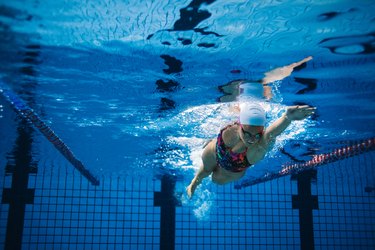
There are four typical strokes in swimming: butterfly, backstroke, breaststroke and freestyle. Each of the four strokes has its own technical aspects and recruits separate muscles. If you're looking at a full-body workout, you can cross breaststroke and backstroke off your list.
While they are great for swimming, they do not call for as much exertion as freestyle and butterfly do. These two have very many similarities, but one does stand above the other for a total-body workout: the butterfly, says Swimming.org.
Video of the Day
Video of the Day
Yes, butterfly is king if you're looking for a butt-kicking, energy-draining, muscle-shredding workout in the water.
The Top Two: Muscles
Taking a look at the two top most effective swimming strokes, you can see the difference and distinguish that one stands above the other. First, there are the muscles used. In freestyle, a person uses 48 muscles. In the fly, you use these same 48 muscles with the main propulsive muscles being the lats, pecs and quads according to British Swimming.
Next you should look at the amount of exertion the stroke places on these 48 muscles. In freestyle, you are moving muscles in a reciprocating motion like the push-pull of a train, so while one side is working the other is recovering. In butterfly, you use all the muscles together to push first and then pull.
The Top Two: Breathing
Another huge factor to consider when deciding which stroke offers more of a workout is the cardiovascular system and what demands are being placed on it. The breaths taken during the stroke are the first thing to look at in this. Freestyle allows for a breath on every other arm stroke while butterfly allows a breath at every arm stroke.
It might seem like you have more opportunity to get air during the butterfly stroke but the two even out to be about the same, usually between two and five seconds per breath. Next consider that you are producing more force with your muscles in the fly, this causes you to use more oxygenated blood to feed your muscles which means your lungs and heart start working harder to produce even more oxygenated blood.
Read more: Do You Get Ripped From Swimming?
The Butterfly Stroke
To do the butterfly, first push yourself through the water with a powerful kick to propel your body forward, followed by another smaller kick to push your body upward. When under the water, keep your hands and arms generally straight and create a knife-like shape to help you cut through the water.
Once your smaller kick has propelled you toward the surface, begin using your arms to push the water down and behind you. Once your upper body has broken the surface, take a deep breath and bring your arms back around to the knife-like position. Dive back in to the water and repeat with another big kick followed by a small kick.
Butterfly: Big Benefits
Every swim stroke calls on parts of the core to help keep you balanced while you move through the water. Butterfly uses your entire core. It also uses most of the prime movers in your body. This stroke calls on your pectorals, latissimus, trapezius, quadriceps, hamstrings, shoulders and hips.
Basically any "show" muscle on your body is used to produce force. By coupling the use of all these muscles and the extreme call on your heart and lungs, you get the best calorie-burning, muscle-building swim from the butterfly stroke.